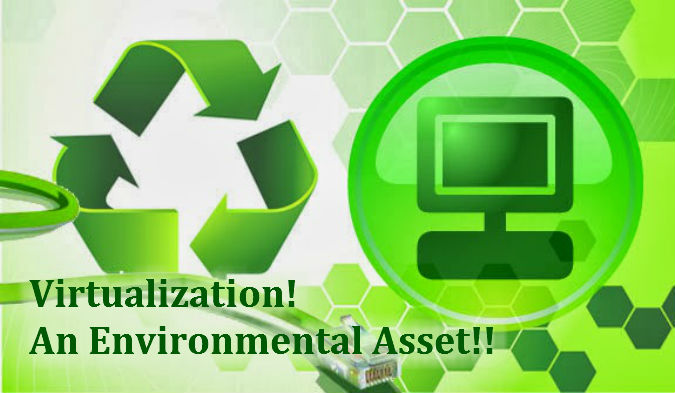Virtualization – An Environmental Asset!
Virtualization
In this age of rapid upgradation and the need for progression, electronic devices are easily prone to get outdated. This results in sums of e-waste. World’s e-waste is anticipated to grow 33% by 2017 according to the global reports. Accumulation of e-waste prompts to resource shortage and environmental contamination, making it a disquiet to give a thought upon and take opted steps towards ‘Virtualization’ to make greener tomorrow!
Virtualization can be the simplest and cost efficient step taken to reduce e-waste. It comes hand in hand with the aid of reduction in CAPEX (Capital Expenditure) & OPEX (operational Expenditure) resulting in ‘TOTAL PROFIT’. Virtualization as the concept specifies an act of creating something (such as Computer Hardware, OS, Storage, etc.) virtually, to facilitate one with the similar comfort of operations as provided in the physical environment, but of course with aid of advantages.
Virtualization has three levels:
Hardware level virtualization: In this hardware is virtualized similar to the physical machine. It is also called as system level virtualization in which Physical machine is called as host and the virtual machine is called as Guest. It has three types of virtualization:
(1) Full Virtualization:
Hardware is completely simulated with the software called as hypervisor which directly interacts with the hardware to allow virtual machine reflect every aspect of physical machine. Every individual virtual machine runs of different platform unaware of another virtual machine, one virtual machine may have Linux as OS and other may have Windows.
(2) Partial Virtualization:
Hardware is not completely simulated, only some part of target environment is simulated. Hence, few modifications in guest instructions may be required to suit virtual environment. It is highly reliable in sharing computer resources between multiple users with different virtual environments.
(3) Para Virtualization:
Hardware is not simulated but similar software interface is provided to the virtual machine. Every virtual machine operates individually in different environment, but guest instructions need to be modified to suit virtual environment.
Hence, Hardware virtualization results in reduction of IT Hardware such as CPU, Memory devices, Storage devices, Network devices, etc. ultimately resulting in lowering of IT e-waste and power consumption.
Application level virtualization: It hosts multiple Applications in separate environment than lurking OS. Ex. Suppose an application needs to be run on different OS environment i.e. other than the host OS, then virtual machine runs the required OS for that application being host on the same OS. This result in ease of maintenance and upgradation, free from any OS restrictions and reduction in required cost to carry machines physical environment for respective OS, and provides flexibility for the user.
OS level virtualization:
It hosts multiple virtualized environments inside one OS ground Ex. Required OS can be run through virtual machine without altering original OS. This results in reduction of Physical machines in an organization required for different environments and cost related to it, along with reduction in power consumption prompting to energy saving.
Example of virtualization can be explained with ‘Server virtualization‘ in which several virtual servers run on single physical server to completely utilize the hardware resource of physical server.
- Server virtualization minimizes cost required to invest in individual physical servers (Hence, supports business with low infrastructure investments, providing Infrastructure as a service).
- It reduces space required for carrying individual physical servers in an organization, as servers are virtualized with only one physical server which is carried by data center (Hence, facilitates space utilization).
- It reduces power consumption in carrying individual physical servers. Each physical server consumes more than 450W of power (excluding cooling), resulting in cost related with power consumption of each physical server. E.g. an organization carries 10 physical servers, hence total power consumption is 10×450=4500W. Whereas, if virtualization is used, power is consumed only by one physical server in datacenter which can be >50% less of carrying 10 physical servers (including cooling).
- Provides software as a service, facilitating software virtualization, which includes OS and application virtualization.
Virtualization being a blessing for organizations provides cost and productivity effective outcomes also equally contributes in going green, by serving:
- E-waste reduction by reducing data center footprint
- Energy saving & significant cost reduction
- Efficiency in resources management & Space utilization
- Business agility & Productivity
With the knowledge of benefits of Virtualization, it is indeed An Environmental Asset, proving a boon for optimal utilization of IT resources and resolving environmental issues, arising due to IT e-wastes, rise in power consumptions and space utilization, globally, towards greener tomorrow!!!
- Embrace the Future with Cloud Computing! - September 8, 2015
- Cloud computing impact on growth of ecommerce applications - August 25, 2015
- 6 Reasons that Cloud Computing is transforming Banking Sector - August 24, 2015
